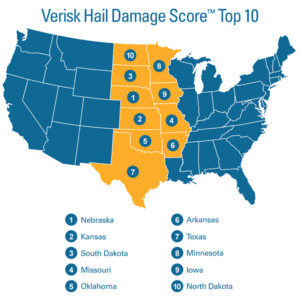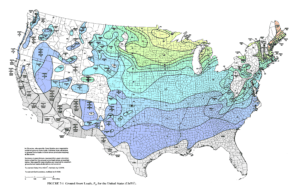In a world acutely aware of the changes in weather, protection from that weather has become a growing concern. Hail is one type of weather that can cause a lot of damage to property, especially cars. Hail is the result of warm and cold systems colliding. Protection from hail looks different in warm and cold climates. Failing to have adequate protection from hail storms could have disastrous financial consequences.

Pictures of the extreme hail have been all over the news in the past couple of years with headlines like “Hail stones the size of oranges rain down on Pescara, Italy” On Demand News July 11, 2019 or “Record breaking hailstone in Colorado: ‘big hail like this can easily kill people’” AccuWeather Sep 4, 2019. WeatherSolve Structures is no stranger to hail or hail protection.
Typically hail storms occur from spring to fall when there is enough instability to cause a thunderstorm. The strong warm air (updraft) pushes the rain up and into freezing temperatures. The stronger the updrafts the longer a hail stone typically stays rolling around in the storm cloud collecting ice and becoming larger. In the summer, the freezing level is high and there is often time for the ice to melt again before it reaches the ground – although a very large hail stone will not melt quick enough and can still cause damage. In the spring and fall however, the freezing level is lower allowing the hail to stay formed when it reaches the ground. In line with this, there is a considerable amount more hail in areas higher in elevation as the ground is closer to the freezing level. One very well-known area is “hailstorm alley” that begins in Alberta Canada and follows the Rocky Mountains down to “hail alley” in southeast Wyoming, northeast Colorado, western Nebraska and Kansas. This alley is home to some of the most frequent and most damaging hail storms.
Because hail occurs in the collision between warm and cold, WeatherSolve Structures sees a range in climates requiring hail protection. Not only do we see warm climates with hail but we see cold climates as well.
Typically, the further away from the equator and/ or the higher in altitude, the colder a climate becomes.
In colder climates, clients are looking for hail protection during hail season and open skies in the winter. In the winter, the canopy requires retraction for three reasons:
Due to WeatherSolve’s superior standards and custom designs, we provide structures that require less poles than our competitors. This makes snow removal easier and frees up precious real-estate for your inventory and snow storage.

A warm climate is typically experienced by clients close to the equator. In these locations the sun becomes scorching in the summer and hail storms are common from spring to fall.
In warmer climates, our client’s typically have two main objectives: hail protection and shade. For these clients WeatherSolve Structures recommends a structure that stays up all year. This option would provide clients with a strong dependable hail protection as well as shade from the canopy in the summer. Shade is essential so that cars do not become so hot that they are unpleasant to get into.

Insurance providers are encouraging car sales companies to use hail protection canopies like WeatherSolve Structures’. Car companies are seeing the benefit immediately both with insurance premiums and a feeling of reassurance. According to Randy Klym, Sales Manager of Country Hills Nissan: “We have experienced over the past years where we did not have appropriate protection and the hail damage frankly, were in the hundreds of thousands of dollars. He goes on to say: “with this hail net protection it will protect our inventory properly which gives us peace of mind and actually keeps our insurance rate at a much more manageable level”.
Whether you are looking for hail protection in warm or cold climates, WeatherSolve has an appropriate canopy for your company. Our flexibility in custom design ensures that you have the right solution at the right price.
